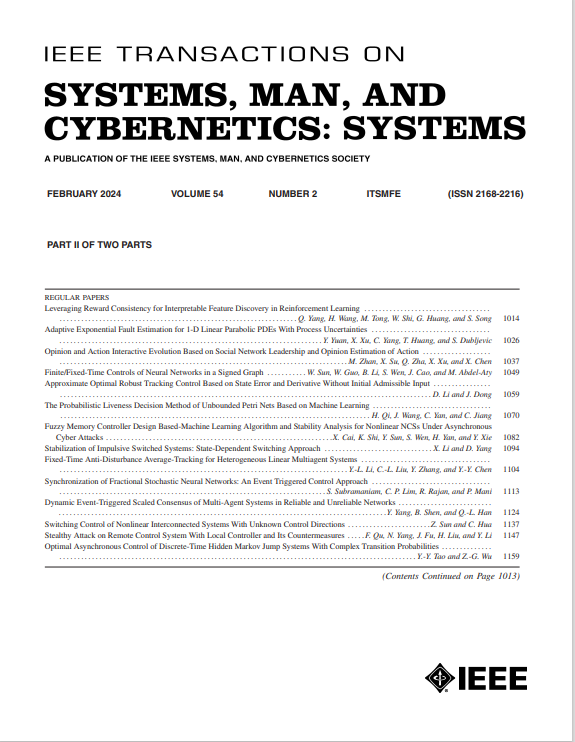不确定车辆超椭圆编队跟踪:一种简化的强化学习能量优化方法
IF 8.6
1区 计算机科学
Q1 AUTOMATION & CONTROL SYSTEMS
IEEE Transactions on Systems Man Cybernetics-Systems
Pub Date : 2025-03-24
DOI:10.1109/TSMC.2025.3548081
引用次数: 0
摘要
本文研究了多台无人飞行器超椭圆最优编队跟踪控制问题,其中每台飞行器都包含未建模基本阻力的非线性不确定性,能量优化目标分别包括超椭圆轨道法线方向上的超椭圆轨道跟踪能量和超椭圆轨道切线方向上的编队运动能量。通信拓扑是有向领导-跟随结构。为了避免使用相邻机动车辆的输入和全局通信信息,设计了一种新的增强编队输入,并将其集成到编队运动子系统中。针对Hamilton-Jacobi-Bellman方程中存在的不确定非线性、不确定虚拟leader信息以及相邻muv信息有限等问题,设计了一种基于辨识神经网络和优化反演技术的简化强化学习(RL)能量优化方法。对系统误差进行了理论稳定性分析。仿真结果表明,超椭圆编队跟踪能耗明显降低,算法运行时间明显缩短。本文章由计算机程序翻译,如有差异,请以英文原文为准。
Super-Ellipse Formation Tracking of Uncertain Vehicles: A Simplified Reinforcement Learning Energy Optimization Method
This article deals with the optimal super-ellipse formation tracking control problem for multiple unmanned vehicles (MUVs), where each vehicle contains nonlinear uncertainties of unmodeled basic resistance, and the objective of energy optimization includes the super-ellipse orbit tracking energy and formation motion energy on the normal and tangent directions along the super-ellipse orbits, respectively. The communication topology is the directed leader-following structure. To avoid using the inputs of neighboring MUVs and the global communication information, a novel augmented formation input is designed and integrated into the formation motion subsystem. To deal with the uncertain nonlinearity, the uncertain virtual leader information, and the limited information of neighboring MUVs in the Hamilton-Jacobi–Bellman equations, a simplified reinforcement learning (RL) energy optimization method is designed based on identifier neural networks (NNs) and optimized backstepping technique. Theoretical stability analysis of system errors are given in detail. Simulation results show that the super-ellipse formation tracking energy consumption is significantly saved and the algorithm run time is decreased through comparison.
求助全文
通过发布文献求助,成功后即可免费获取论文全文。
去求助
来源期刊

IEEE Transactions on Systems Man Cybernetics-Systems
AUTOMATION & CONTROL SYSTEMS-COMPUTER SCIENCE, CYBERNETICS
CiteScore
18.50
自引率
11.50%
发文量
812
审稿时长
6 months
期刊介绍:
The IEEE Transactions on Systems, Man, and Cybernetics: Systems encompasses the fields of systems engineering, covering issue formulation, analysis, and modeling throughout the systems engineering lifecycle phases. It addresses decision-making, issue interpretation, systems management, processes, and various methods such as optimization, modeling, and simulation in the development and deployment of large systems.
 求助内容:
求助内容: 应助结果提醒方式:
应助结果提醒方式:


